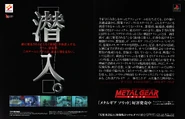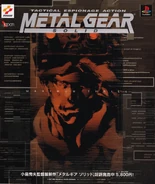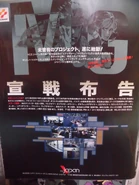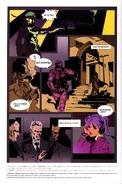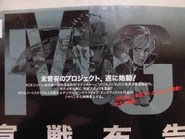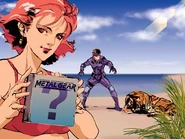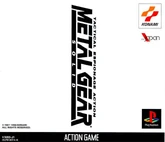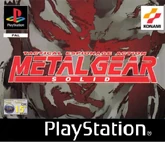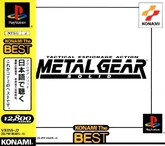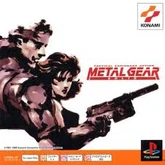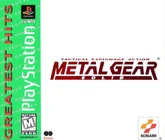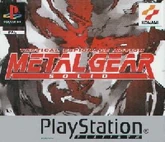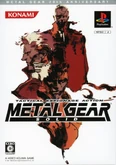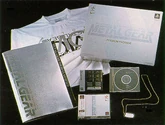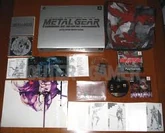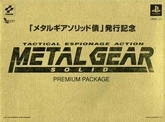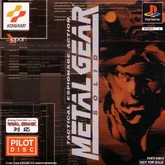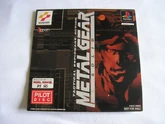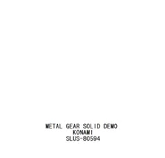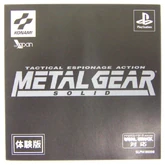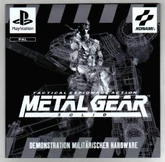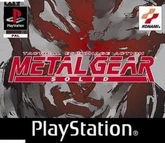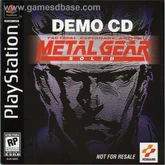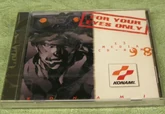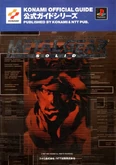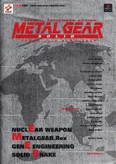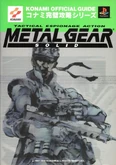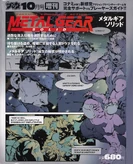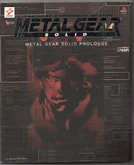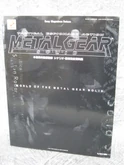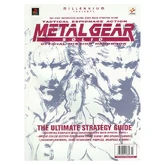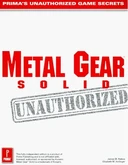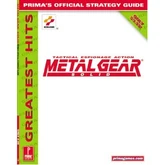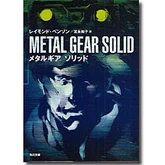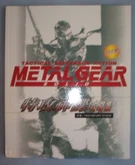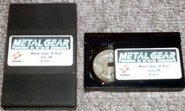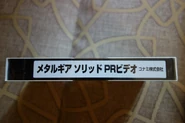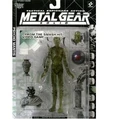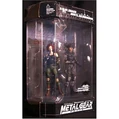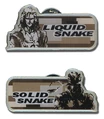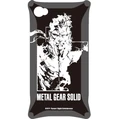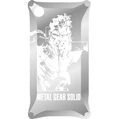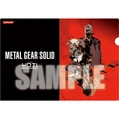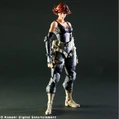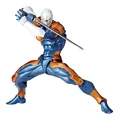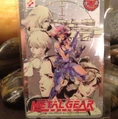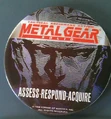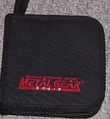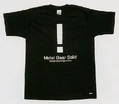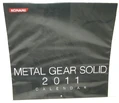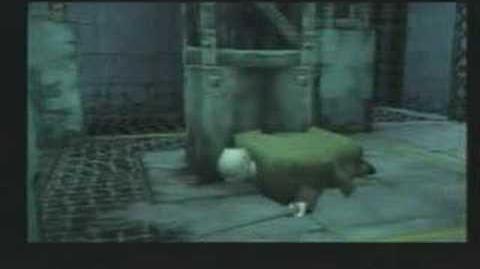| This article is about the video game, Metal Gear Solid. You may be looking for Metal Gear: Ghost Babel, which was released outside of Japan as Metal Gear Solid. |
Metal Gear Solid (メタルギアソリッド Metaru Gia Soriddo?, commonly abbreviated as MGS or MGS1) is a stealth action video-game directed by Hideo Kojima. The game was developed by Konami Computer Entertainment Japan and first published in 1998 for the PlayStation.[1] It was well-received critically and commercially, shipping more than six million copies (being the eighth best-selling game on the PlayStation),[2] and scoring an average metascore of 94 out of 100 on Metacritic.[3] It is widely considered to be one of the greatest and most important games of all time,[4][5] and is heralded as the game that made the stealth genre popular.[6] It is the third canonical title released in the Metal Gear series, being a sequel of Metal Gear 2: Solid Snake.
The commercial success of Metal Gear Solid prompted Konami to enhance and re-release the game for the PlayStation and Windows PC under the title Metal Gear Solid: Integral;[6] a remake, Metal Gear Solid: The Twin Snakes was later released for the Nintendo GameCube.[7]
Plot[]
| Metal Gear chronology |
|---|
| Metal Gear Solid 3: Snake Eater (1964) Metal Gear Solid: Portable Ops* (1970) Metal Gear Solid: Peace Walker (1974) Metal Gear Solid V: Ground Zeroes (1975) Metal Gear Solid V: The Phantom Pain (1984) Metal Gear (1995) Metal Gear 2: Solid Snake (1999) Metal Gear Solid (The Twin Snakes) (2005) Metal Gear Solid 2: Sons of Liberty (2007/2009) Metal Gear Solid 4: Guns of the Patriots (2014) Metal Gear Rising: Revengeance* (2018) |
During a training mission in late February 2005 on Shadow Moses, a remote island off the coast of Alaska containing a nuclear weapons facility, FOXHOUND and the Next-Generation Special Forces rebelled against the United States Government, under the command of Liquid Snake. Their target was the advanced weapon system Metal Gear REX, a gigantic robotic weapons platform with worldwide nuclear strike capabilities. Their demand was the body of the greatest soldier who ever lived, Big Boss, which, through gene therapy, they could use to create an army of ultimate soldiers.
With the safety of the entire world at stake, at the request of the Secretary of Defense, Colonel Roy Campbell, the former commander of FOXHOUND, summoned Solid Snake out of retirement for one last solo covert operation to stop Liquid.
- For a full plot summary, see Shadow Moses Incident.
Cast[]
Most of the English voice actors were credited under pseudonyms since they did not know if the project was supported by the Screen Actors Guild. The only ones who used their real names were David Hayter (Solid Snake), Doug Stone (Psycho Mantis), and Scott Dolph. In the German version, Nastasha Romanenko's voice actress, Birgit Khan, is incorrectly credited as "Brigit Khan."
| Character | Voice actor | |||||
|---|---|---|---|---|---|---|
| English (pseudonyms) | Japanese | German | French | Italian | Spanish | |
| Solid Snake | David Hayter (Sean Barker) |
Akio Ōtsuka | Stephan Grothgar | Emmanuel Bonami | Alessandro Ricci | Alfonso Vallés |
| Liquid Snake / Master Miller | Cam Clarke (James Flinders) |
Banjō Ginga | Michael Hulsmann | Stéphane Cornicard | Andrea Pirovan | Riki Coello |
| Meryl Silverburgh | Debi Mae West (Mae Zalder) |
Kyoko Terase | Britta Gartner | Framboise Gommendy | Ilaria D'elia | Ana Maria Camps |
| Naomi Hunter | Jennifer Hale (Carren Learning) |
Hiromi Tsuru | Gertrud Thoma | Linda Sans | Jessica Juffré | Meritxell Ane |
| Hal Emmerich | Christopher Randolph (Christopher Fritz) |
Hideyuki Tanaka | Erich Redmann | Nicholas Mead | Massimo Marinoni | Quique Hernandez |
| Roy Campbell | Paul Eiding (Paul Otis) |
Takeshi Aono | Michael Mellinger | Philippe Smolikovski | Angelo Cola | Vicente Gil |
| Mei Ling | Kim Mai Guest (Kim Nguyen) |
Houko Kuwashima | Nicole Kehrberger | Vanessa Seydoux | Laura Farina | Noemi Bayarri |
| Gray Fox | Greg Eagles (George Byrd) |
Kaneto Shiozawa | Sebastian Michael | Olivier Deslandes | Massimo Marinoni | Jose Javiar Serrano |
| Nastasha Romanenko | Renee Raudman (Renee Collette) |
Eiko Yamada | Brigit Khan | Cécile Hopkins | Benedetta Ferraro | Marta Estrada |
| Revolver Ocelot | Patric Zimmerman (Patric Laine) |
Kōji Totani | Wolf Kähler | Philippe Smolikovski | Giancario Ciccone | Javier Amilibia |
| Vulcan Raven | Peter Lurie (Chuck Farley) |
Yukitoshi Hori | Werner Kastor | Pierre Maubouché | Joaquin Gomez | |
| Psycho Mantis | Doug Stone | Kazuyuki Sogabe | Stefan Boje | Philippe Monnet | Ciro Carraro | Francesc Rocamora |
| Sniper Wolf | Tasia Valenza (Julie Monroe) |
Naoko Nakamura | Nichola Thomasoni** | Framboise Gommendy | Luciana Icci | Ana Orra |
| Donald Anderson / Decoy Octopus | Greg Eagles (George Byrd) |
Masaharu Satō | Wolf Kähler | Stéphane Cornicard | Andrea Pirovan | Javier Amilibia |
| Kenneth Baker | Allan Lurie (Bert Stewart) |
Yuzuru Fujimoto | Peter Zander | Daniel Pageon | Luigi Chiapinni | Paco Alborch |
| Jim Houseman | William Bassett (Fredrick Bloggs) |
Tomohisa Asō | Wolf Kähler | Philippe Monnet | Javier Amilibia | |
| Johnny Sasaki | Dean Scofield (Dino Schofield) |
Naoki Imamura | Stefan Boje | Olivier Deslandes | Quique Hernandez | |
| Genome soldier A | Doug Stone | Masaya Takatsuka | Sebastian Michael | |||
| Genome soldier B | Peter Lurie (Chuck Farley) |
Naoki Imamura | ||||
| Enemy soldier | Dean Scofield (Dino Schofield) Scott Dolph |
|||||
| Computer voice | Tasia Valenzia (Julie Monroe) |
Naoko Nakamura | Nichola Thomasoni | Cécile Hopkins | Meritxell Ane | |
- ^ This credit only appears in early demo versions of the game and in the back of some versions of the user manual under Cast and Credits in the European version. Hayter did not use a pseudonym in the game credits.
Theme[]
Genetics is the theme behind this game, or the idea of nature vs. nurture. In the ending, Liquid has an opportunity to kill Snake but the FOXDIE virus gets him first. Since Liquid and Snake are identical, it is implied that Snake will eventually be killed by FOXDIE as well. The idea of genes expands beyond the family tree with the Genome Army. Due to being genetically-enhanced with Big Boss' "soldier genes", they are also a part of Big Boss' "legacy."
Another theme is how genetic engineering can be used in a number of ways and whether or not it is good or bad is a matter of personal opinion.[8]
Gameplay[]
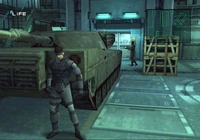
Solid Snake hiding from a guard.
Despite a transition to 3D, Metal Gear Solid's gameplay remains similar to Metal Gear 2. The player must navigate Solid Snake through the game's areas without being detected.[9] Detection will set off an alarm, which draws armed enemies to his location.[10] To return to a lower alert setting, the player must hide, and remain undetected by the enemy until the timer reaches zero.[11]
To remain undetected, the player must make use of Snake's abilities and the environment, such as crawling under objects, using boxes as cover, ducking or hiding around walls, and making noise to distract the enemy. These are carried out in the third-person camera view; which slowly changes its angle to give the player the best strategic view of the area possible, and an on-screen radar, which displays enemy personnel and their field of vision.[12] Snake is armed with many items and gadgets, such as thermal goggles and a cardboard box for use as a disguise, as well as numerous weapons.[13] This emphasis on stealth promotes a less violent form of gameplay, as firefights against large numbers of enemies who posses superior equipment will likely result in heavy damage and often death for the protagonist, especially early on in the game when less potent guns are available.[14]
The game contains plot-progressing cutscenes and radio conversations (known as the Codec), as well as encounters with the bosses. To progress, the player must discover the weaknesses of these enemies in order to defeat them. This is where the player will most often use the game's weapon-set, ranging from pistols and assault rifles to rocket launchers and grenades. Game controls and play strategies can also be accessed via the Codec, where advice is delivered from Snake's support crew; for example, the support team may chastise Snake for not saving his progress often enough, or explain his combat moves in terms of which buttons to press on the gamepad. Completion of the game provides the player with a statistical summary of their performance, and a codename based upon it, typically the common name of an animal.[15]
In a first for the Metal Gear series, the player can partake in VR Training, a training mode in which they can practice hiding techniques, weapons use, and sneaking. In addition to the stealth gameplay, there are set-piece sequences that entail firefights between the player and the enemy from the third-person and first-person perspectives.[11]
Development[]
Hideo Kojima originally planned to release the third Metal Gear game, Metal Gear 3, for the 3DO Interactive Multiplayer in 1994.[16] While producing the 3DO version of his adventure game Policenauts, concept art by illustrator Yoji Shinkawa of Solid Snake, Meryl Silverburgh, the latter also appears in Policenauts, and the FOXHOUND team, were included in the Policenauts: Pilot Disk preceding the release of the full 3DO game in 1995.[17] However, due to the declining support for the 3DO, development of the game was shifted to the PlayStation shortly after the 3DO version of Policenauts was released. Part of the reason why Kojima wanted to do a sequel to Metal Gear was because it was his first game when he joined Konami, so it had a special place for him, as well as exploring further the concepts of stealth that Metal Gear brought to light, with the PlayStation giving him the opportunity to do so.[18] The plot point of a renegade American special forces unit taking control of a nuke on US soil was originally meant to be the plotline for Metal Gear 2: Solid Snake, although Kojima had nixed it during that game's development due to believing it to be too unrealistic. He ultimately used it for Metal Gear Solid largely due to the growing changes in society in the aftermath of the Cold War.[19]
Kojima decided to re-title the game as Metal Gear Solid. He did this because he believed that the first two MSX2 games weren't well known at the time.[15] In fact, he initially intended to remake Metal Gear altogether before ultimately deciding to do a sequel instead.[18] According to Kojima, the "Solid" in the title has three meanings: a reference of Solid Snake, the game's use of 3D graphics, and Konami's rivalry with Square.[20] In addition, he also stated that, while similar in some respects to the then-recent release of the Capcom game Resident Evil in terms of tension-related gameplay, he indicated that Metal Gear Solid would give a different take to the heart-racing gameplay. He also indicated that prior projects of his such as Policenauts and Snatcher acted as an inspiration for the more drama-focused aspects of the game.[18]
Development for Metal Gear Solid began in mid 1995[21] with the intent of creating the "best PlayStation game ever."[22] Developers aimed for accuracy and realism while making the game enjoyable and tense. In the early stages of development, a SWAT team educated the developers with a demonstration of vehicles, weapons and explosives.[22] Kojima stated that "if the player isn't tricked into believing that the world is real, then there's no point in making the game." To fulfill this, adjustments were made to every detail, such as individually designed desks.[23]
Kojima created the characters of Metal Gear Solid; modifications and mechanics were made by conceptual artist Shinkawa. The characters were completed by polygonal artists using pencil drawings and clay models by Shinkawa.[24] The designers would sometimes use Lego pieces to put the levels together.[25]
Kojima wanted greater interaction with objects and the environment, such as allowing the player to hide bodies in a storage compartment. Additionally, he wanted "a full orchestra right next to the player"; a system which made modifications to the currently playing track, instead of switching to another pre-recorded track. Although these features could not be achieved, they were implemented in Metal Gear Solid 2: Sons of Liberty.[26]
Metal Gear Solid was revealed to the public at E3 1997 as a short video. It was later playable for the first time at the Tokyo Game Show in 1998 and officially released the same year in Japan with an extensive promotional campaign.[27][22] Television and magazine advertisements, in-store samples, and demo giveaways contributed to a total of US$8 million in promotional costs.[28]
During development, to promote the game's release in various gaming magazines, Shinkawa developed a two-page comic promoting the game. It featured Solid Snake having an encounter with Revolver Ocelot, telling the latter to go to Hell as he points his gun at him. Ocelot then replies that Hell if anything is already coming to their current location. Snake then leaves, although not before sarcastically laughing and telling Ocelot to get stuffed as the narration quizzically asks about the Gates of Heaven. Meanwhile, Jim Houseman is discussing with two men as the narration asks what Metal Gear is, with Mei Ling asking if Snake is okay.
Nearing its North American release, one of the first commercials depicted a soldier doing basic, kindergarten-level "rigorous training" for a mission that was supposed to be top secret. When the accompanying soldier questions whether the tests are too easy for the soldier, the commander reminds him that he's prepping him for a suicide mission. The commercial then ends with Snake apparently being killed by Vulcan Raven's tank. The Metal Gear Solid Facebook page, when uncovering this ad in June 29, 2012, pointed out that, had Snake's training been anything like the soldier in the commercial, he most likely would never have made it beyond the docking area of Shadow Moses.[29]
Music[]
- Main articles: Metal Gear Solid Original Game Soundtrack and Metal Gear Solid Original Game Score
Metal Gear Solid's musical score was composed by in-house musicians at Konami, including Kazuki Muraoka, who also worked on Metal Gear. Composer and lyricist Rika Muranaka provided a song called "The Best is Yet to Come" for the game's ending credits sequence.[30] The song is performed in Irish by Aoife Ní Fhearraigh.[31] The main theme was composed by TAPPY.[30]
Music played in-game has a synthetic feel with increased pace and introduction of strings during tense moments, with a looping style endemic to video games. Overtly cinematic music, with stronger orchestral and choral elements, appears in cutscenes. The soundtrack was released on September 23, 1998, under the King Records label.[32]
Release history[]
Original version[]
The English version of Metal Gear Solid (translated by Jeremy Blaustein) contains minor refinements made during localization, such as adjustable difficulty settings (including an Extreme setting available after completing the game, which adds extended guard vision and removes the Soliton Radar, among other changes), a bonus tuxedo outfit for Snake, and a Demo Theater for viewing cutscenes and Codec conversations.
Versions of the game dubbed in Spanish, German, French and Italian were released thorough Europe in addition to the English version released in North America.
A premium package was also released in Japan and the PAL region. The Japanese release contained a special box, the game with the inclusion of the demo version of Suikoden II, FOXHOUND army dog tag, a T-shirt, metallic memory card sticker sheet, the Metal Gear / Metal Gear 2: Solid Snake Music Collection soundtrack, and a history and art book.[33] A stock holder version was also released and only given out to Konami stock holders. The only difference between this and the original is that the box is golden and the cover of the art book was different. Everything else remains the same. The PAL version contains the game with the inclusion of the demo of Silent Hill, the Metal Gear Solid Original Game Soundtrack, T-shirt, double sided poster, Metal Gear Solid/Konami dog tags, metallic memory card sticker sheet and six postcards. The history and art book was not included with this version.[34]
Expanded version[]
Integral[]
- Main article: Metal Gear Solid: Integral
Metal Gear Solid: Integral is an expanded version of Metal Gear Solid released only in Japan in 1999. Integral is essentially a re-localized version of Metal Gear Solid based on the English version. Integral features most of the added content from the international versions of Metal Gear Solid which were not featured in the initial Japanese release.
The game was also packaged with an additional disc of extra missions known as the VR Disc, which was released as a standalone game internationally as Metal Gear Solid: VR Missions in North America and as Metal Gear Solid: Special Missions in Europe.
Integral serves as the basis for the PC version of Metal Gear Solid.
The Twin Snakes[]
- Main article: Metal Gear Solid: The Twin Snakes
Metal Gear Solid: The Twin Snakes is a 2004 remake of Metal Gear Solid that was developed by Silicon Knights and Konami. It was released for the Nintendo GameCube.
The Twin Snakes features graphical improvements over the original, new cutscenes written and directed by Ryuhei Kitamura, and gameplay functions originally introduced in Metal Gear Solid 2: Sons of Liberty. The game also includes a revised translation with re-recorded voice acting using all of the original English voice cast. Hideo Kojima and Shigeru Miyamoto oversaw development of the game.
Digital Graphic Novel[]
- Main article: Metal Gear Solid: Digital Graphic Novel
Other re-releases[]
The original PlayStation version of Metal Gear Solid, as well as Integral, had been reissued twice: once under The Best range and second time as a PSOne Books title. Likewise, the North American and European versions of the original Metal Gear Solid were reissued under the Greatest Hits and Platinum ranges respectively. The game is included in the Japanese Metal Gear 20th Anniversary: Metal Gear Solid Collection (in addition to a standalone 20th anniversary edition)[35] and in the North American Essential Collection.[36]
A Bleemcast! version was made for the Sega Dreamcast and released in the early 2000s. It is a high resolution of the original Metal Gear Solid with enhanced graphics and requires that the player owns both the Bleemcast! disc and the original game.[37]
The game was re-released in the Japanese PlayStation Network on March 21, 2008, as part of the PSOne Classics.[38] It was released in the North America PlayStation Network on June 18, 2009[39] and in the European PlayStation Network on November 19, 2009.[40]
Metal Gear Solid was not included as part of the Metal Gear Solid: HD Collection due to both its gameplay and visuals seen as being too dated. However, rather than solely create a HD remastered version of the original game, Kojima Productions planned to re-imagine the story and gameplay to an extent at some point in the future, although this was not on their immediate agenda.[41]
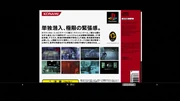
Digital download manual showing the "back of the package".
On August 9, 2012, Konami Europe stated that, in honor of the 25th Anniversary of the Metal Gear series, the PlayStation Network version of Metal Gear Solid would be sold at a discount of £3.99 instead of £7.99 for two weeks, starting on August 8.[42] The download versions likewise incorporated the front and back of the package with the digital manual, thus allowing for the player to fulfill the mandate of finding Meryl's frequency.[43]
On December 3, 2018 Sony released the Playstation Classic mini console which included Metal Gear Solid which is included in the 20 games list. Also this game has a save state feature not included in the original release.
Metal Gear Solid was among the various Metal Gear games included in Metal Gear Solid Master Collection Vol.1, with it also including the Integral version as well as the option to play in differing languages and also including a scenario/script book. For the PlayStation 5 and Xbox X|S versions of the collection, it also included Trophy/Achievement support.
Possible second remake[]
In December 2011, UK Official PlayStation Magazine had a mini interview with Kojima. He stated that "There are a lot of people wanting remakes of the original, and as producer I want to answer those calls", followed by "But as a creator I'm not very interested in going back. If we were to do it, it would have to be a total remake – the only thing that would be the same would be the story. If it happened at some point I would stay as a producer, but would have to hand off most of the actual creating."[44]
He also added, "I was just making the game I wanted to make. Looking back, there’s not anything in particular I want to go back and fix. If you change anything, you change the game – and I want to avoid that. If you bring the gameplay up to modern standards, then you lose a bit of the original game. It was a game made for a certain era – not just the story, but the controls and everything about it reflect that era in which the game was made."[45]
On June 25, 2013, Kojima told Gamereactor that he had a desire to remake Metal Gear Solid with the Fox Engine.[46]
On August 13, 2014, Kojima stated that he would consider developing a second remake of Metal Gear Solid. On his Twitch channel, he stated that "personally, I’m not too fond of remakes. But I would have to go with MGS1. If it was going to be a remake, I wouldn’t want to make a standard remake, but something similar to what Planet of the Apes is doing: Bringing the best of the past to the present and doing something new."[47]
During the 2015 Taipei Game Show, Kojima stated that he would like to see a remake of Metal Gear Solid that features an open world Shadow Moses.[48]
On February 22, 2019 (Japan time), Konami has hinted at possibly making a remake of Metal Gear Solid.[49]
References in other games[]
Aside from canonical sequels to the game, there is at least one game in the series that featured a non-story reference to it.
In Metal Gear Solid V: Ground Zeroes, the Metal Gear Solid logo was featured on a wooden wall in the Déjà Vu/Jamais Vu missions. Kazuhira Miller, when doing commentary on the Easter eggs in the game, quoted Otacon's "Are you an Otaku, too?" line and also said "If we make it through this, I'll tell you."[50] The Déjà Vu mission itself also heavily referenced Metal Gear Solid at various points, owing to it being the 10th anniversary of the game's release.
Reception[]
| Reviews | |
|---|---|
| Publication | Score |
| Allgame | 5/5 |
| Edge | 9/10 |
| GameSpot | 8.5/10 |
| IGN | 9.8/10 |
| NGamer | 9/10 |
| Compilations of multiple reviews | |
| Metacritic | 94 out of 100 (based on 20 reviews) |
| GameRankings | 93.75% (based on 28 reviews) |
Metal Gear Solid was a commercial success, shipping over 6 million copies worldwide.[2] Upon release, it was one of the most rented games, and topped sales charts in the United Kingdom.
The game was generally well received by the media and some of the most prominent gaming critics. Users and critics of GamePro gave it an average score of 4.8 out of 5 calling it "this season's top offering [game] and one game no self-respecting gamer should be without." However, they criticized the frame rate, saying it "occasionally stalls the eye-catching graphics" and "especially annoying are instances where you zoom in with binoculars or the rifle scope", and also the interruptions of "advice from your team", in the early parts of the game, "that's listed in the instruction manual", calling it an "annoyance." GameSpot also criticized this, saying "it needlessly interrupts the game." They also criticized how easy it is for the player to avoid being seen and its short length and called it "more of a work of art than ... an actual game." Further criticism came from the website Adrenaline Vault, which said it had "some serious...flaws" which "made it a complete disappointment."
It received an Excellence Award for Interactive Art at the 1998 Japan Media Arts Festival. NGamer said "It's like playing a big budget action blockbuster, only better." IGN said it came "closer to perfection than any other game in PlayStation's action genre" and called it "Beautiful, engrossing, and innovative...in every conceivable category."
Metal Gear Solid is recognized by some as the first 3D stealth game (Tenchu: Stealth Assassins is actually the first as it was released a few months earlier). The idea of the player being unarmed and having to avoid being seen by enemies, rather than fight them, experienced a resurgence in popularity, and has been featured in many games since. It is also sometimes acclaimed as being a film as much as a game due to the lengthy cut scenes and intricate storyline. Entertainment Weekly said it "broke new ground with...movie-style production...and stealth-driven gameplay, which encouraged...hiding in boxes and crawling across floors." GameTrailers said it "invented the stealth game genre" and called it "captivating, inventive and gritty." The game is widely considered to be one of the best PlayStation games, and has featured in numerous greatest video games ever lists by GameFAQs, Japanese magazine Famitsu, Entertainment Weekly, Game Informer, GamePro, Electronic Gaming Monthly, and GameTrailers. However, it's placing in these lists is inconsistent, ranging anywhere from second to 50th.
In 2002, IGN's editors ranked it as the best PlayStation game ever. IGN writer David Smith said that just the demo for the game had "more gameplay [in it] than in most finished titles." They also gave it the "Best Ending" and "Best Villain" awards. In 2005, in placing it 19th on their list of "Top 100 Games", saying that it was "a game that truly felt like a movie", that the fights were "unique and innovative", and that it was "the founder of the stealth genre."
In other media[]
Strategy guide[]
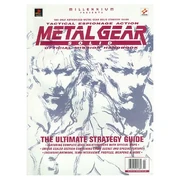
Millennium Books' Metal Gear Solid: Official Mission Handbook.
A strategy guide for the game, titled Metal Gear Solid: Official Mission Handbook, was published by Millennium Books in 1998. The book was written by David S. J. Hodgson, who went on to write many Prima official game guides.
Authorized by Konami, the book includes a foreword by Hideo Kojima, and features additional information on various characters and equipment, such as Big Boss, Decoy Octopus, Sniper Wolf, Liquid Snake, Revolver Ocelot and Ocelot's torture device. It also features interviews with some members of the development staff, including Kojima, a brief overview of the previous games, a plot summary of the MSX2 games, a character relation chart, and an art gallery.
Some of the additional character information introduced by the guide was later featured on the game's Japanese website (albeit exclusive to the accompanying English text), and was also repeated in the 1999 Metal Gear Solid Official Strategy Guide by Piggyback Interactive. However, due to story developments in later games, it is unclear how much of this should be considered canonical.
Radio drama[]
A Japanese radio drama version of Metal Gear Solid was produced shortly after the release of the original PlayStation game. Directed by Shuyo Murata and written by Motosada Mori, it aired, in 18 segments, from 1998 to 1999 on Konami's CLUB db program. The series was later released on CD as a two volume set. Set after the events of the PlayStation game, Snake, Meryl, Campbell and Mei Ling (all portrayed by their original Japanese voice actors) pursue missions in hostile third world nations as FOXHOUND. Original characters are introduced, such as Sgt. Allen Iishiba, a Delta Force operative who assists Snake and Meryl; Col. Mark Cortez, an old friend of Campbell who commands the fictional Esterian Special Forces; and Capt. Sergei Ivanovich, a former war buddy of Revolver Ocelot from his SVR days.
Comic[]
In September 2004, IDW Publications began publishing a series of Metal Gear Solid comics, written by Kris Oprisko and illustrated by Ashley Wood. 12 issues have been published, fully covering the game's storyline.
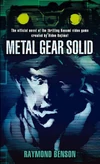
The front cover of the novelized adaptation.
Novelization[]
Raymond Benson[]
A novelization based on the original Metal Gear Solid was written by Raymond Benson and published by Del Rey. The American paperback edition was published on May 27, 2008,[51] with a UK edition released on June 4, 2008. A podcast nearing the release of Metal Gear Solid 4 also revealed that Hideo Kojima was directly involved in supervising the written work.
In the novelization, Snake seems to have a slightly more perverse, humorous, and almost sarcastic nature than in the original game, e.g. responding to Naomi Hunter's offer of a strip search with "WHOA! When do I start!?" and often delivering comedic one liners before killing Genome Soldiers. Also, Snake seems to kill more often, such as wiping out almost every guard at the heliport, whereas he has previously been portrayed as sneaking by enemies if possible, rather than fighting them, although Liquid implied in the original game as well as its remake that Snake may have wiped out a majority of Liquid's men as well as with some joy.[52][53]
The novel shed light on the mysterious Les Enfants Terribles project, stating some of the people involved, and where it took place. It also provides more information on the death of Master Miller and the true gender of Dr. Clark.[54]
Hitori Nojima[]
On August 4, 2015, it was announced that Hitori Nojima, the author of the novelization of Metal Gear Solid: Peace Walker, was writing three novelizations, including one, titled Metal Gear Solid Substance I - Shadow Moses, that's based on the events of Metal Gear Solid. The book is 544 pages in length. It was released on August 25.[55][56]
Legacy[]
Eurodance group Eiffel 65's song "My Console," which is on their album Europop, makes tribute to many hit PlayStation games, including Metal Gear Solid.
Metal Gear Solid along with Metal Gear Solid 2 was featured in the Smithsonian American Art Museum's "The Art of Video Games" exhibition from March 16 to September 30, 2012.[57]
"Shadow Moses", a song by Bring Me the Horizon on their Sempiternal album, is a reference of the location of the same name.[58]
On December 3, 2018, Metal Gear Solid was released on the PlayStation Classic as part of the 20 games list in both the American and Japanese versions.
Gallery[]
Promotional material[]
Packaging[]
Demos[]
Books[]
Videos[]
Merchandise[]
Paraphernalia[]
Posters & wallpaper[]
Trailers[]
External links[]
See also[]
| Walkthrough Alert! |
|
We have a walkthrough for this game. Click here to view it |
- Solid Snake
- List of Metal Gear Solid bosses
- Metal Gear Solid secrets
- Character Gallery/Metal Gear Solid
- Similarities between games
References[]
- ^ Metal Gear Solid Tech Info/Credits - GameSpot
- ^ a b Metal Gear Solid 3 Exclusive For Sony. Gameplanet (2003-05-15).
- ^ Metal Gear Solid for PlayStation Reviews. Metacritic. Retrieved on 2014-05-25.
- ^ GT Countdown Video Game, Top Ten Best And Worst Games Of All Time | Video Clip
- ^ The Top 10 Best / Greatest Video Games of All Time
- ^ a b Metal Gear Solid Integral Review - GameSpot
- ^ Metal Gear Solid: The Twin Snakes - GameCube - IGN
- ^ Hideo Kojima Speaks - IGN
- ^ Metal Gear Solid - IGN
- ^ Metal Gear Solid (PC) review - GameSpot
- ^ a b Metal Gear Solid instruction manual, Konami Computer Entertainment Japan (1998).
- ^ Metal Gear Solid Strategy Guide - GameSpot
- ^ Metal Gear Solid – Overview
- ^ Metal Gear Solid PC – Instructional Manual
- ^ a b Metal Gear Solid: Official Mission Handbook, Millennium Books (1998).
- ^ KOJIMA PRODUCTIONS - HIDECHAN RADIO - Episode 148
- ^ Konami. Policenauts Pilot Disk. 3DO Interactive Multiplayer. (in Japanese).
- ^ a b c https://thearkhound.tumblr.com/post/189640385948/famitsu-403-hideo-kojima-interview-metal-gear
Metal Gear has a special feeling Metal Gear is quite an old game. Why did you decide to make a sequel after all this time? Hideo Kojima: Metal Gear came out in 1987. Has it really been ten years? The truth is that Metal Gear was actually the first game that I’ve made when I’ve joined Konami. There’s that emotional attachment, as well as a feeling of tension of “being seen or not by the enemy” that was characteristic of Metal Gear that I wanted to explore further. For example, let’s say your character hides under a desk. When that happens, the point of view changes to under the desk and the nearby soldiers will walk around making noises. Or you hear the footsteps of a soldier, so you quickly hide inside a locker to avoid making noises. I wanted to express that kind of tension. I had the same concept with the original Metal Gear, but I wasn’t able to express it with the hardware available at the time. However, we finally have a 32-bit console capable of using many polygons, so I can finally do what I wanted to.- So you had the idea for over ten years?
- It seems there are a lot of things you can do with the current 32-bit consoles that couldn’t be done with the older hardware at the time.
- So will this new Metal Gear game serve as a conclusion to the previous games?
- Can you explain in detail what kind of game is it?
- It doesn’t sound a flashy game where all you just shoot stuff.
- Sounds similar to another game that became a hit recently.
- Can you tell us a rough outline of the story?
- So you’re saying there will be an element of human drama involved similar to the ones in Snatcher and Policenauts…
- In other words, finding a balance between the action-based portions and the story you want to show is pretty important.
- Can you explain that?
- You don’t want to interrupt the flow of the game as much as possible.
- What kind of world are you building with that much attention?
- ^ https://twitter.com/Arc_Hound/status/1297208246672019456
- ^ Hideo Kojima: Game Guru, Movie Maniac. Games Today. Retrieved on 2007-07-07.
- ^ Metal Gear Solid Comes to the Nintendo 64 - GameSpot
- ^ a b c Metal Gear Solid Casts Its Spell. GameSpot.
- ^ More News From Metal Gear Solid Creator - IGN
- ^ The Art of Design: MGS2 & Z.O.E.. IGN.
- ^ Hideo Kojima talks life, influences at USC presentation. Engadget.
- ^ E3: Hideo Kojima Interview - IGN
- ^ The Metal Gear Timeline
- ^ Metal Gear Gears Up. GameSpot (1998-10-16). Retrieved on 2014-05-25.
- ^ http://www.facebook.com/mgs/posts/407644582604140
- ^ a b Metal Gear Solid Game Credits
- ^ Collaborations | Aoife Ní Fhearraigh
- ^ Metal Gear Solid Original Game Soundtrack
- ^ Metal Gear Solid Premium Package
- ^ Metal Gear Solid Limited Edition Premium Package Scans
- ^ http://www.konami-asia.com/products/en/gs_mg_20th_mg_solid_collection_ps2/index.html
- ^ Metal Gear Solid: The Essential Collection - PlayStation 2 - IGN
- ^ Bleem!cast Scans
- ^ http://www.jp.playstation.com/software/title/jp0101npjj00145_000000000000000001.html
- ^ https://store.playstation.com/#!/en-us/games/metal-gear-solid-(ps3-psp)/cid=UP9000-NPUJ00594_00-0000000000000001?emcid=ps-se-717&utm_medium=Paid_Search_{ps}&utm_campaign=Playstation&utm_source=Google&utm_term=ps-se-717&utm_content=Brand
- ^ https://store.playstation.com/#!/en-gb/games/metal-gear-solid/cid=EP0101-NPEF00036_00-GMETALGEAR000001
- ^ Konami wants to "re-imagine" MGS in HD. Eurogamer. Retrieved on 2011-06-10.
- ^ http://www.konami-europe.net/MG25th/en/25th-anniversary-sale/
- ^ https://twitter.com/HEITAIs/status/906132923530674176
- ^ Hideo Kojima Addresses Calls for a Metal Gear Solid Remake. Game Kudos. Retrieved on 2011-12-26.
- ^ Hideo Kojima Wouldn’t Change a Thing About Metal Gear Solid. PlayStation LifeStyle. Retrieved on 2011-12-26.
- ^ The Mysterious Mr. Kojima - Gamerector UK - Metal Gear Solid V: The Phantom Pain
- ^ Gamescom 2014: Kojima Still Interested in Metal Gear Solid Remake. IGN. Retrieved on 2014-08-14.
- ^ Kojima Would Like an Open World Current-Gen Remake of Metal Gear Solid, But No One Wants to Make it
- ^ http://ebitsu.net/archives/78442366.html
- ^ http://i.imgur.com/HNRbhGZ.jpg
- ^ ISBN 0345503287
- ^ Metal Gear Solid, Konami Computer Entertainment Japan (1998).
Solid Snake: I don't want that kind of world! // Liquid Snake: Ha! You lie! So why are you here then? Why do you continue to follow your orders while your superiors betray you? Why did you come here? // Solid Snake: ...... // Liquid Snake: Well... I'll tell you then. You enjoy all the killing, that's why. // Solid Snake: What! // Liquid Snake: Are you denying it? Haven't you already killed most of my comrades? // Solid Snake: That was... // Liquid Snake: I watched your face when you did it. It was filled with the joy of battle. [...] That’s right... The Genome Soldiers that you’ve [Solid Snake] been killing are our brothers, with the same genes as ours. - ^ Metal Gear Solid: The Twin Snakes, Konami Computer Entertainment Japan (2004).
Solid Snake: I don't want that kind of world! // Liquid Snake: Ha! You lie! So why are you here then? Why do you continue to follow your orders while your superiors betray you? Why did you come here? // Solid Snake: ...... // Liquid Snake: Well... I'll tell you then. You enjoy all the killing, that's why. // Solid Snake: What! // Liquid Snake: Are you denying it? Haven't you already killed most of my men? // Solid Snake: That was... // (red-toned flashback to Snake killing a Genome soldier) // Liquid Snake: I saw the look on your face. It was filled with such vitality. [...] That’s right... The Genome Soldiers that you’ve [Solid Snake] been killing left and right are our brothers, with the same genes as ours. - ^ Metal Gear Solid 4 Afterthoughs with Ryan Payton - 1UP.com
- ^ http://www.metalgearinformer.com/?p=21057
- ^ http://www.amazon.co.jp/dp/4041032288/ref=cm_sw_r_tw_dp_HsJUvb0GGNT90
- ^ The Art of Video Games
- ^ Bring Me The Horizon ● Interviews ● exclaim.ca
External links[]
- Official website (Japanese)
- Original official website (Japanese, Waybacked)
- Metal Gear Solid on Moby Games
- Metal Gear Solid on GameFAQs

